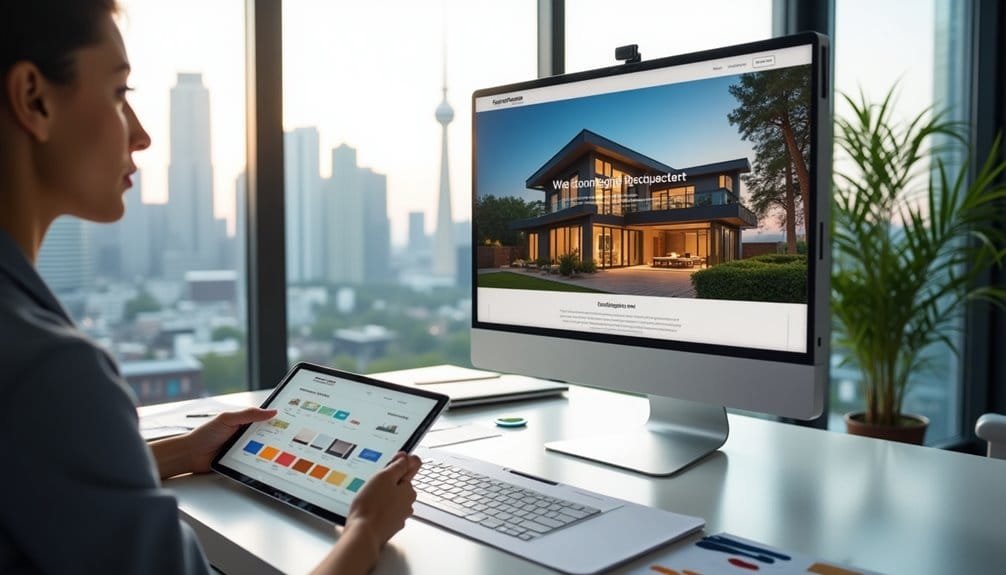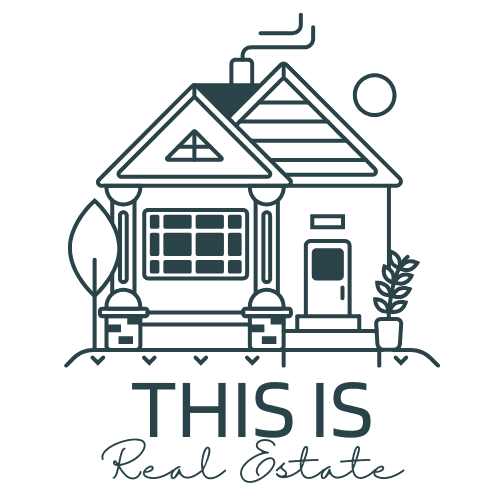Creating a strong real estate website involves focusing on user experience, with emphasis on user-centric design strategies. Verify the site is responsive and mobile-optimized, considering 89% of clients use their phones during home searches. Implement clear navigation and advanced search features to simplify user experience, with elements resizing smoothly across devices. High-quality visuals like high-resolution images, video tours, and aerial photography enhance property display, making listings more appealing. Engaging content, including educational articles and market insights, can convert visitors into clients. Incorporate SEO techniques and analytics tools to improve visibility and track performance, setting a foundation for continued success.
Key Takeaways
- Implement user-centric design with clear navigation and responsive features to enhance accessibility and user satisfaction.
- Optimize search functionality with advanced filters and keyword search capabilities for efficient property discovery.
- Use high-quality visuals and interactive elements to create an engaging and dynamic user experience.
- Provide local market insights and educational resources to inform and guide potential buyers effectively.
- Employ SEO and analytics tools to improve search engine visibility and understand user behavior.
Design Strategies

Designing a real estate website with user-centric strategies is imperative for engaging visitors and converting them into clients. You need to focus on clear navigation, guaranteeing your menu structure is simple and organized. This helps users find what they’re looking for without frustration.
Implementing a user-friendly search feature with filters like location, price range, and property type makes it easier for potential clients to narrow down their options quickly. Advanced search functionality with location-based options and filtering by property type, features, and price range settings can significantly enhance the user experience by ensuring they find relevant property listings effortlessly.
A responsive design is essential, allowing your website to adapt seamlessly to desktops, tablets, and smartphones, which enhances user experience and accessibility. Incorporate breadcrumbs to help users understand their location on the site easily.
Fast load times are non-negotiable; optimize your site to prevent delays, as this can greatly affect user satisfaction and engagement. High-quality visuals such as professional photography and virtual tours can significantly increase interest and conversions, improving the overall user experience on the website.
Make certain your website is accessible to all users by including clear headings, easy-to-read fonts, and alt text for images. Proper contrast between background and foreground colors is critical for visibility.
Following accessibility standards guarantees a seamless experience for everyone, including those using mobile devices. By adhering to these design strategies, you’ll create a website that not only attracts visitors but also converts them into loyal clients.
High-Quality Visuals
While clear navigation and user-centric designs are key to a successful real estate website, incorporating high-quality visuals elevates user engagement to a whole new level. You want visitors to experience properties in their full glory, and high-resolution images are essential for showcasing intricate details and luxury features.
Aerial photography offers a unique perspective, highlighting the property’s location benefits, while video tours provide an immersive feel, enhancing the user’s experience. Make sure that all photos and videos are well-lit and professionally taken to maintain a consistent brand aesthetic that reinforces a luxury image.
Visual storytelling is another element to take into account. Full-screen images and videos captivate visitors immediately, while matte photography adds a touch of elegance and luxury. Interactive elements like black and white images evolving to color upon hover, along with animated shifts, bring dynamism to your site.
Text overlays and captions offer additional context, enriching the user’s understanding of the property. Websites like North Jersey Partners effectively use a clean, functional site to highlight visuals, ensuring potential buyers are drawn to the high-quality imagery. Adding a mobile-responsive design ensures that these visuals are accessible across all devices, enhancing user interaction and engagement.
From a technical standpoint, prioritize fast loading speeds and mobile-responsive design to guarantee visuals are optimized across devices. Regular updates keep your visuals fresh, while SEO optimization boosts search visibility. Consistent branding and high-quality imagery across listings complete the experience, making your site memorable and engaging.
Search and Navigation

To create an effective real estate website, a seamless search and navigation experience is essential. Start by incorporating a clear search interface with a prominent search bar on your homepage. This allows users to quickly find properties, while advanced search filters by location, price range, and amenities refine their search. Adding keyword search capabilities can help users locate specific features like “beachfront” or “pool”. Auto-complete functionality will speed up the process by suggesting options as users type, and sorting options for search results by relevance, price, or newest listings make it easier to find the right property.
Designing a simple navigation structure is vital. Limit items to essential categories such as “For Sale” and “For Rent”, and implement drop-down menus for easy access to property types and features. Breadcrumbs are useful for showing users their current location on the site, ensuring they don’t get lost. Responsive designs adapt navigation to different screen sizes, enhancing user experience on mobile devices and making sure that users can access your listings seamlessly from anywhere. Consistent navigation across all pages enhances user experience by allowing visitors to navigate more intuitively.
Here are three key practices to enhance user experience:
- Intuitive Navigation: Guide users through the site logically.
- Consistent Navigation: Keep navigation consistent throughout.
- Navigational Feedback: Use visual cues to confirm user actions.
Responsive and Mobile Design
For a real estate website to truly succeed, you must implement responsive and mobile design. With 89% of real estate clients using mobile devices during their home search, making certain your site adapts to various screen sizes is essential. Given that 52% of global web traffic comes from mobile devices, ensuring a mobile-friendly experience is crucial to capturing and retaining potential clients.
Responsive design automatically resizes elements, providing a seamless experience whether on a smartphone or tablet. This adaptability not only enhances user satisfaction but also boosts your site’s visibility on Google, as search engines prioritize responsive sites, improving SEO rankings. Google reports that 61% of users are unlikely to return to non-responsive sites, underscoring the importance of having a mobile-optimized platform to retain potential clients.
Incorporating responsive features like automatic resizing makes certain that property photos and detail pages look flawless across devices. This attention to detail keeps visitors engaged, reducing bounce rates and increasing lead generation.
Mobile navigation becomes intuitive with “sticky” menu bars, offering quick access to essential site sections. Design with mobile-first in mind, making certain easy scrolling and full-screen videos.
Responsive design is a vital tool for accessibility, allowing users to interact with your content comfortably. It simplifies maintenance by eliminating the need for separate mobile and desktop sites, saving you time.
Additionally, mobile-friendly sites encourage content sharing on social media, attracting more visitors and positioning your site as a 24/7 lead generation tool.
Engaging Content

Engaging content is critical for capturing and retaining the attention of potential clients on your real estate website. By offering valuable information and insights, you can turn passive browsers into active buyers. Here’s how you can create compelling content:
- Local Market Reports: Share detailed analyses of neighborhood factors affecting home costs, such as foreclosure rates, the local economy, and debt-to-income ratios. Real estate content marketing focuses on selling more than just properties; it emphasizes dreams and opportunities. Use timely and relevant data to draw in potential buyers, ensuring your reports attract attention and build trust. This kind of content addresses various stages of the buyer’s journey and keeps them informed.
- In-Depth Property Descriptions: Craft high-quality blog posts that explore individual properties, highlighting unique features and amenities. Use SEO best practices to boost visibility and include engaging images and videos for a more immersive experience. These detailed descriptions make your listings stand out and accessible to readers.
- Educational Articles: Provide general educational content about the home buying process. Articles on what to look for and avoid in properties, as well as the real estate agent’s role, are invaluable. Employ clear language and include calls-to-action to encourage further engagement, building your authority and helping clients make informed decisions. By integrating SEO-optimized educational articles with keywords, you can improve search engine rankings, increasing the likelihood of attracting potential buyers.
SEO and Analytics Tools
Steering through the world of SEO and analytics tools is vital for any real estate agent aiming to enhance their website’s performance and visibility.
To start, Google Keyword Planner is a free and invaluable resource for discovering relevant keyword ideas, understanding search volumes, and gauging competition levels. Tools like SEMrush and Ahrefs further refine this process, offering extensive insights into keyword difficulty and competitor strategies, helping you uncover new opportunities for growth.
Google Analytics serves as a cornerstone for understanding your website’s performance, providing insights into organic traffic, user behavior, and conversion rates.
Complementing this, Google Search Console allows you to monitor and maintain your website’s presence in search results, guaranteeing peak visibility.
For local SEO, Google My Business is essential for managing your business listings and boosting local search visibility.
Tools like Moz Local and BrightLocal help maintain consistent business information across directories, enhancing your local online presence.
Utilizing these tools guarantees your real estate website remains competitive and visible in local searches.
Frequently Asked Questions
- Prepare for Loan Maturities and Refinancing Waves as a Real Estate AgentIn mastering loan maturities and refinancing waves, uncover strategies every real estate agent needs to empower clients during pivotal financial transitions.
How Can Agents Best Showcase Their Unique Expertise on Their Website?
To showcase your unique expertise on your website, highlight your niche skills, like virtual staging or celebrity client experience.
Create informative blog posts to demonstrate your knowledge, and publish e-books or guides on topics like real estate investment.
Display client testimonials to build trust and feature updates on ongoing projects.
These elements, combined with high-quality visuals and interactive content, will effectively position you as an expert in the real estate field.
What Interactive Features Enhance User Engagement on a Real Estate Website?
You can boost user engagement on a real estate website by incorporating interactive features like virtual tours and interactive floor plans, which offer immersive property views.
Polls and surveys engage users, providing valuable feedback, while quizzes and calculators educate them on real estate processes.
Walkability widgets enhance lifestyle-focused browsing.
These tools not only capture attention but also provide valuable information, fostering enhanced decision-making and user satisfaction on your platform.
Recent Posts

Essential Skills Every New Real Estate Agent Needs

The Importance of Setting Daily Goals as a Real Estate Agent
How Should Agents Personalize Their Website to Reflect Their Brand Identity?
To personalize your website and reflect your brand identity, guarantee a consistent brand voice across all content and tailor your messaging to meet specific audience needs.
Use customizable templates to create a distinct aesthetic and segment content for different buyer personas.
Incorporate interactive elements like chatbots for enhanced user experience.
This approach not only reinforces brand identity but also engages visitors, making your site a powerful tool for connection and conversion.
How Can Virtual Tours Be Effectively Integrated Into Property Listings?
You can effectively integrate virtual tours into property listings by embedding them directly on your listing page, providing potential buyers with an immersive experience right from the start.
Use high-quality images and thorough coverage to capture every detail. Confirm the tours are compatible across devices, offering easy access.
Highlight their benefits to clients, like fewer physical showings. Customization, like adding hotspots and audio, enhances the experience, making properties more appealing.
What Strategies Can Agents Use to Connect Their Social Media to Their Website?
You can connect your social media to your website by incorporating several strategies.
Start with adding social media icons and links on your homepage and listings for cross-promotion.
Guarantee consistent branding across all platforms, and share engaging content to drive traffic back.
Use embedded feeds and social media widgets for dynamic visibility.
Encourage interaction through CTAs and exclusive offers, and track engagement metrics to refine your approach and measure success.
Bottom Line
By incorporating design strategies, high-quality visuals, and effective navigation, you’ll create a real estate website that stands out. Isn’t it important for your site to be responsive and mobile-friendly, ensuring accessibility for all users? Engaging content, paired with robust SEO and analytics tools, will keep visitors returning and boost your site’s visibility. By focusing on these elements, you’re not just building a website; you’re establishing an essential tool for success in the competitive real estate market.







